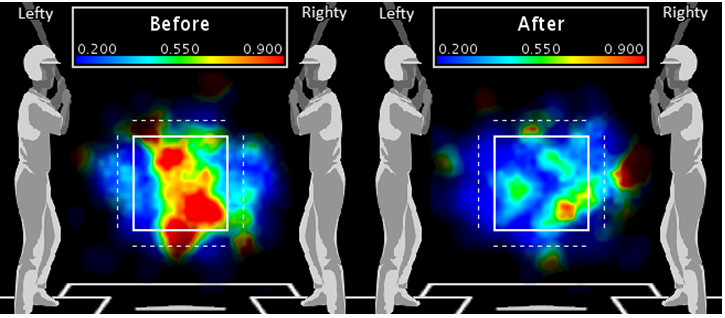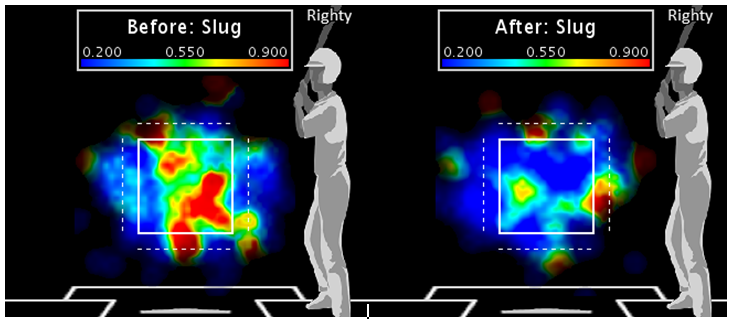Last season, Atlanta Braves starter Mike Minor’s performance varied dramatically before and after the All-Star break.
|
|
GS |
IP |
W |
H |
ER |
HR |
BB |
SO |
AVG |
ERA |
|
Pre All-Star |
16 |
92 |
5 |
91 |
61 |
19 |
40 |
78 |
.263 |
5.97 |
|
Post All-Star |
14 |
87.1 |
6 |
60 |
21 |
7 |
16 |
67 |
.197 |
2.16 |
Below are heat maps of the opposing hitter’s slugging percentage before and after the All-Star break. It doesn’t take a statistician or a scout to see why he got pummeled in the first-half of the season.
Before I started to dive into the statistical data I remembered a fantastic article Ben Lindbergh wrote at Baseball Prospectus where he had three theories for Minor’s resurgence after the All-Star break:
- He mixed up his pitches, specifically using the curveball and slider more.
- The fastball became a better pitch.
- His luck improved.
Sequencing pitches is necessary for any starter to be successful in the big leagues. Without it, big league hitters will have the advantage because they will:
A) Be comfortable in the batter’s box.
B) Allow them to more accurately guess which pitch will be thrown next.
There are exceptions of course; Mariano Rivera’s wizard pitch, the cutter. It’s the only pitch he throws. Everyone in the stadium knows it, but he’s still able to be extremely effective.
Before the All-Star break, Minor threw his fastball and changeup, his best secondary pitch, 75.77% of the time with the remainder going to the curveball and slider —13.3% and 10.93% respectively. In Ben’s article he quotes a scout who said Minor became more effective because he began incorporating his curveball and slider more. He/she was correct…somewhat. After the All-Star break he threw the fastball and changeup only 72.4% of the time. The result of mixing his pitches was he became more effective in every sense of the way; hitters made weaker contact, they struck out more and whiffed (swinged and missed) more.
|
% Thrown |
AVG |
SLG |
K% |
Whiff% |
||||||
|
Before |
After |
Before |
After |
Before |
After |
Before |
After |
Before |
After |
|
|
Fastball |
59.0% |
58.6% |
.266 |
.207 |
.482 |
.33 |
17.5% |
21.2% |
12.5% |
18.4% |
|
Change |
16.7% |
13.8% |
.268 |
.151 |
.507 |
.264 |
12.3% |
14.0% |
27.1% |
29.8% |
|
Curveball |
13.3% |
11.7% |
.200 |
.179 |
.289 |
.25 |
42.9% |
33.3% |
42.4% |
33.3% |
|
Slider |
10.9% |
15.9% |
.323 |
.222 |
.742 |
.378 |
21.9% |
15.6% |
25.4% |
15.6% |
|
Totals |
100% |
100% |
.263 |
.197 |
.486 |
.318 |
19.6% |
20.2% |
19.8% |
21.8% |
The key to Minor’s resurgence was incorporating the slider more. Not only did he throw it more, he threw it more regardless of the count. The table below shows the pitch frequency and batting average by count type. PCs represent pitchers counts and HCs represent hitters counts.
|
Velocity |
Strk% |
GB% |
FB% |
LD% |
||||||
|
Before |
After |
Before |
After |
Before |
After |
Before |
After |
Before |
After |
|
|
Fastball |
93.4 |
93.1 |
63.9% |
66.0% |
31.7% |
31.7% |
47.2% |
47.2% |
21.1% |
21.1% |
|
Change |
88.1 |
86.9 |
62.5% |
64.8% |
37.9% |
41.3% |
40.9% |
47.8% |
21.2% |
10.9% |
|
Curveball |
83.4 |
82.5 |
56.0% |
54.7% |
40.0% |
52.6% |
24.0% |
31.6% |
36.0% |
15.8% |
|
Slider |
86.9 |
85.2 |
54.7% |
63.5% |
29.2% |
34.2% |
54.2% |
44.7% |
16.7% |
21.1% |
|
Totals |
93.3 |
92.9 |
60.7% |
63.9% |
33.7% |
35.5% |
44.2% |
45.7% |
22.1% |
18.8% |
The heat map below shows the slugging percentage of his the fastball, changeup, and curveball after he started throwing the slider more.
We’re in an age of instant gratification. Whether it’s buying online, communicating with our friends through social media (except for Google Hangout; no one’s using that), or instantly streaming a fantastic show like White Collar on your TV, everything comes to us instantly. As fans and fantasy owners we see prospects, such as Stephen Strasburg, dominant in the majors immediately after their call up. Don’t forget generational prospects like Strasburg are very rare.
Most prospects require time and fail before they ultimately reach or come as close as possible to their ceiling. Once in the majors they have to make adjustments. Once they’ve made them, the league will make further adjustments and the player will have to make adjustments on those adjustments. Mike Minor learned he couldn’t rely on only his fastball and changeup to get outs. I love prospects who make adjustments because it shows #want. For 2013, I like his chances of continuing the performance he showed after the All-Star break.





